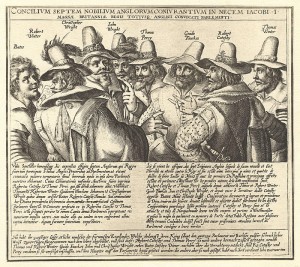
The Gunpowder Treason and Plot,
I know of no reason Why the Gunpowder Treason
Should ever be forgot.
To blow up the King and Parli’ment.
Three-score barrels of powder below
To prove old England’s overthrow;
With a dark lantern and burning match.
Holloa boys, holloa boys, let the bells ring.
Holloa boys, holloa boys, God save the King!*
Today Brits celebrate James I’s narrow escape from assassination in November 1605. It was on the night of the 4th/5th November 1605 that Guy Fawkes was caught red-handed in the cellars beneath Westminster with 36 barrels of gunpowder. He and his fellow Catholic conspirators had planned to blow up the House of Lords at the opening of Parliament on the 5th November, to assassinate King James I and to replace him with his daughter, nine year-old Princess Elizabeth, as a Catholic queen. Although this happened in the reign of James I, it had its origins in that of Elizabeth I – see The Gunpowder Plot for more on this.
On 5th November 1605, Londoners were encouraged to celebrate the King’s narrow escape by lighting bonfires around the city, and it is that celebration that is remembered in the UK every year on 5th November, along with the fireworks which have their origins in Guy Fawkes’ gunpowder. In fact, this celebration to give thanks for the deliverance of the King was made compulsory in the United Kingdom until 1859.
Some people will have a bonfire and fireworks in their backgarden, some will go to organised fireworks displays and still others will see processions like the one in Lewes in Sussex, which is said to be the biggest bonfire night celebration in the world. My husband had family in Lewes so we saw this procession on a few occasions and it is amazing. Here is a video of it for you:
You can find out more about the 1605 plot in my article 5 November – Remembering the Gunpowder Plot of 1605.
Did you know that it was actually Robert Catesby who was behind the plot, not Guy Fawkes? You can read more about Catebsy in my article on his death – click here.
* or Queen as we say now due to Elizabeth II being our monarch.